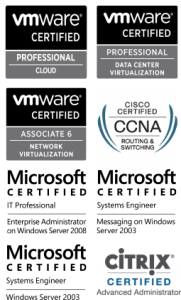Problem
You want to provide some fault tolerance for DHCP, so you plan to add another DHCP server to your network.
You used to have to set up the scopes and exclusions manually, but now you can use the Split-Scope wizard using Server 2008 R2.
Tips, thoughts and notes from the world of IT
You want to provide some fault tolerance for DHCP, so you plan to add another DHCP server to your network.
You used to have to set up the scopes and exclusions manually, but now you can use the Split-Scope wizard using Server 2008 R2.
You need to set some Predefined Options on your DHCP server to allow your VOIP handsets to connect to the phone system etc.
You’ve just tried to install VMware vCenter with the option to use SQL Server Express, but the installation fails with the following error:
The Microsoft SQL Server Express Edition installer returned error code ‘2064843076’
Whilst troubleshooting an issue with backups, I wanted to check the owner of all Maintenance Plans.
I found the following query that does just that:
SELECT sj.name AS JobName, CASE WHEN sj.[Enabled] = 1 THEN 'Yes' ELSE 'No' END AS JobIsEnabled, sl.name AS OwnerName FROM msdb.dbo.sysjobs AS sj INNER JOIN master.dbo.syslogins AS sl ON sj.owner_sid = sl.sid ORDER BY JobName
It’s a pleasant day and all is well with the world. Colleagues are skipping around the office with smiles on faces…until…duh duh daaa! One by one, services start failing:
Basically, your main Domain Controller (DC) has just taken a dump…and so have you!
These are the steps I took to troubleshoot the issues and get everything back online.
I’ve just been reviewing our Maintenance Plans (MPs). After readings a few best practice articles, it seems I’d be better off using scripts instead of MPs.
When using the Reorganise and Rebuild tasks within a MP, they will run regardless of the index fragmentation. Using scripts I could check to see if indexes actually need a little TLC, based on the level of fragmentation, eg.
You have already installed and configured an iSCSI SAN for your shared storage, and now you want to configure a Failover Cluster to provide increased availability to services like Exchange, SQL Server and virtualisation.
Two servers called node01 and node02 have already been joined to the domain, each with multiple Network Interface Cards (NICs).
Microsoft’s iSCSI Initiator was used to connect the volumes (LUNs) on the iSCSI SAN. One disk for Data, the other for the Witness disk.
You’ve installed FreeNAS 8.2 and configured it as a free iSCSI SAN. Now you need to connect to the iSCSI SAN using an iSCSI Initiator.
I’ve read many help files/articles/posts on backup and recovery over the years, but I’ve recently read some of the best yet that have filled in some gaps when it comes to SQL Server:
Using the Microsoft Virtual Academy has been on my TODO list for some time, but for the next two months everyone has free access to the Hands-On Labs from TechEd 2012.
Check them both out now:

Copyright © 2019 · Enterprise Child Theme on Genesis Framework · WordPress · Log in